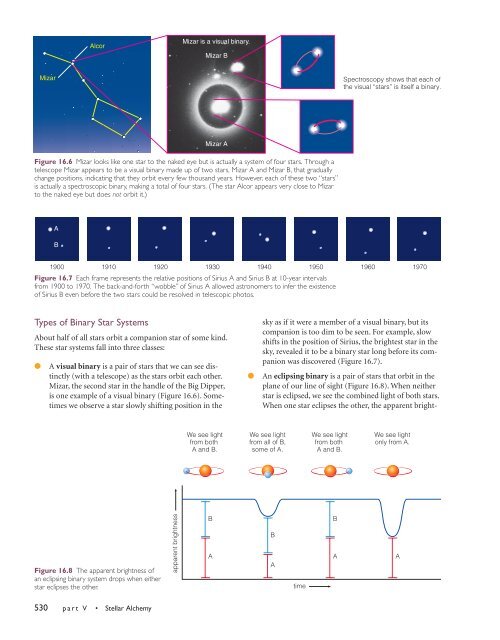Chapter 16--Properties of Stars
Chapter 16--Properties of Stars
Chapter 16--Properties of Stars
Create successful ePaper yourself
Turn your PDF publications into a flip-book with our unique Google optimized e-Paper software.
Alcor<br />
Types <strong>of</strong> Binary Star Systems<br />
About half <strong>of</strong> all stars orbit a companion star <strong>of</strong> some kind.<br />
These star systems fall into three classes:<br />
● A visual binary is a pair <strong>of</strong> stars that we can see distinctly<br />
(with a telescope) as the stars orbit each other.<br />
Mizar, the second star in the handle <strong>of</strong> the Big Dipper,<br />
is one example <strong>of</strong> a visual binary (Figure <strong>16</strong>.6). Sometimes<br />
we observe a star slowly shifting position in the<br />
Figure <strong>16</strong>.8 The apparent brightness <strong>of</strong><br />
an eclipsing binary system drops when either<br />
star eclipses the other.<br />
apparent brightness<br />
Mizar is a visual binary.<br />
Mizar B<br />
Mizar Spectroscopy shows that each <strong>of</strong><br />
the visual “stars” is itself a binary.<br />
Figure <strong>16</strong>.6 Mizar looks like one star to the naked eye but is actually a system <strong>of</strong> four stars. Through a<br />
telescope Mizar appears to be a visual binary made up <strong>of</strong> two stars, Mizar A and Mizar B, that gradually<br />
change positions, indicating that they orbit every few thousand years. However, each <strong>of</strong> these two “stars”<br />
is actually a spectroscopic binary, making a total <strong>of</strong> four stars. (The star Alcor appears very close to Mizar<br />
to the naked eye but does not orbit it.)<br />
A<br />
B<br />
1900 1910 1920<br />
Mizar A<br />
Figure <strong>16</strong>.7 Each frame represents the relative positions <strong>of</strong> Sirius A and Sirius B at 10-year intervals<br />
from 1900 to 1970. The back-and-forth “wobble” <strong>of</strong> Sirius A allowed astronomers to infer the existence<br />
<strong>of</strong> Sirius B even before the two stars could be resolved in telescopic photos.<br />
530 part V • Stellar Alchemy<br />
We see light<br />
from both<br />
A and B.<br />
1930 1940 1950 1960 1970<br />
B<br />
A<br />
sky as if it were a member <strong>of</strong> a visual binary, but its<br />
companion is too dim to be seen. For example, slow<br />
shifts in the position <strong>of</strong> Sirius, the brightest star in the<br />
sky, revealed it to be a binary star long before its companion<br />
was discovered (Figure <strong>16</strong>.7).<br />
● An eclipsing binary is a pair <strong>of</strong> stars that orbit in the<br />
plane <strong>of</strong> our line <strong>of</strong> sight (Figure <strong>16</strong>.8). When neither<br />
star is eclipsed, we see the combined light <strong>of</strong> both stars.<br />
When one star eclipses the other, the apparent bright-<br />
We see light<br />
from all <strong>of</strong> B,<br />
some <strong>of</strong> A.<br />
B<br />
A<br />
time<br />
We see light<br />
from both<br />
A and B.<br />
B<br />
We see light<br />
only from A.<br />
A A
















